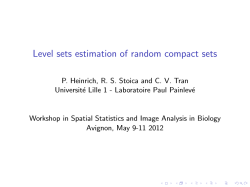
Two Sample Problem
Lecture 3 (Rouen)∞ Two Sample Problem Classical Rank statistics : (a) Wilcoxon Rank Sum 1 2 X1 , X2,…, Xm are iid distributed with D(H(x):θ1), Y1 , Y2,…, Yn are iid with D(H(x):θ2), where H(t) is an unknown continuous distribution function on (-∞,∞). And D(u:θ) is a known continuous distribution function on (0,1). θ1 andθ2 are in some parameter space Θ. We discuss now on this model leading to Theorem 2.1 and Theorem 3.1 3 4 Examples 5 6 7 8 Examples 9 10 11 12 13 14 :***** Note thatθis only in Hθ.(not in F˝-tilda) 15 :**** ;++++++++++++++++++++++ 16 17 18 Remark. The proofs use the convergence of empirical distribution functions for iid cases. Very similar to the one sample problem discussed yesterday, I tend to think that We can replace that with the convergence of empirical processes for weakly dependent cases without changing most of other parts of discussion. 19 20 Thank you for your attention. 21 :*********** The followings are my writing deleted for some correction and/or for rethinking. :***************************** From Miura (1987) Try to see if this relates to M-approximated Rank appro. :***************************************** Remark on a score function :**************************************** 22 :** I thought this relates to the method in the following, but nor?? :************************************************************ This approach is very simple and a little different, in notational-wise, from my approach in Lecture 2 for one sample problem. But these two are essentially the same. The tentative variable θ is docked in ѱ in this paper, but I may use the tentative variable θ in a transformation for transforming Y observations by D(Vj ,θ) and use ѱ that is a function of t in [0,1] without depending onθ and simply satisfy its integral over [0,1] is equal to zero. Hence those two statistics are the same essentially, i.e. the transformation in this paper is done within the ѱ(t, θ) function. By taking r=θ0 + b/√𝐧, we may obtain asymptotic linearity of the statistics. Sn(r)= ∑𝒏𝒋=𝟏 ѱ(𝐕𝐣, 𝐫)=∑𝒏𝒋=𝟏 𝑱(𝑫(𝑽𝒋, 𝒓)) where J(t) is a score function on [0,1] with its integral equal to zero. Those two statistics can be written as an integral by empirical distribution function. :************************************************* 23 ここにある L(.)による変換を行うと元の問題を変えてしまうのでよくない。や はり今の私が言う、一母数+偶然誤差のモデルを置き、偶然誤差に一般化され たレーマン対立仮説モデルを置くのが、正当なモデルだと思う。次の問題は、二 標本モデルの世界で私のモデルが、どのような重要性を持つかという点だ。こ れを知るにはもっと文献を調べないといかん。 What about it if we impose our Generalized Lehmann’s alternative model (GLAM) to the error terms? This is already in there above? No, I t will be some different model. We can convene Lecture2 –one sample statistics for X’s and Y’s here with Y only have location shift The above is only for a location parameter, but we would like to impose a skew (or deforming parameter by GLAM. Prepare two statistics; one for location μ, and the other for thetaθ. Estimator for θ may be defined and obtained uniformly in any location tentative variable q. Is this a new version of ancillarity? Set that locationμbe zero and obtain estimator ofθ. Then, use this estimate of θin the statistic from which we derive estimate of locationμ(in a similar way in One Sample procedure). But, as for location parameter, this will be estimated along the tentative variable for theta come close to the true value so that the transformed Y’s be distributed approximately the same as X’s. This shows that estimator of Location parameterμis not ancillary to estimator of theta, contrary to that estimator ofθis ancillary to estimator of locationμ. Thus, we should first estimate θ, and use that estimator in the statistic based on which estimator of location μbe derived. This makes up a Two Sample problem in a parallel set-up One Sample problem and a Simple Linear Regression model. Two parallel lines; (1) without location, only with theta in One and Two Sample problems and (2) with location in One and Two sample problems and with regression and location in A Simple Linear Regression problem/ :**************************************************** 24 :*********************************************************** 25 26
© Copyright 2025





















